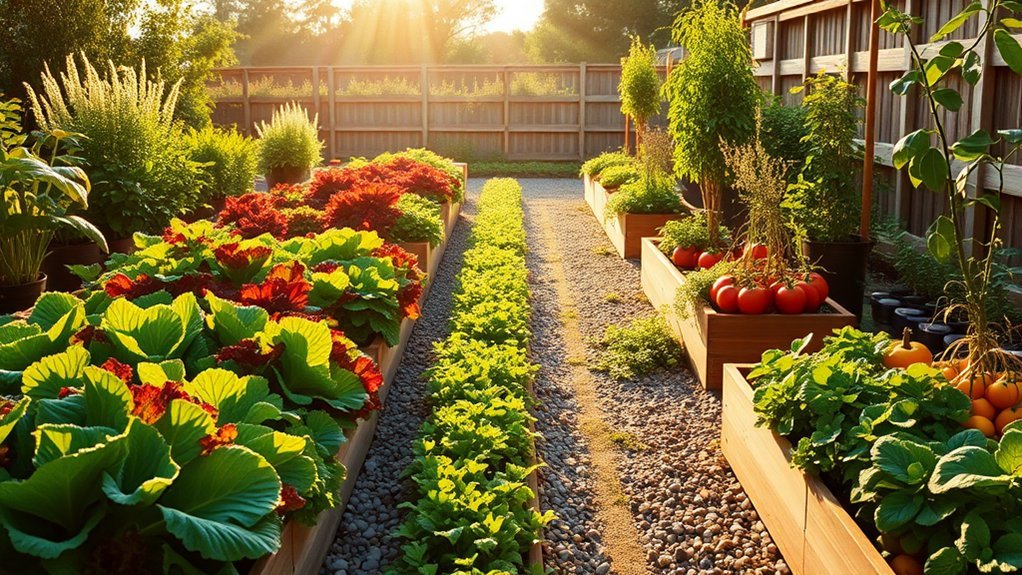Hey, you can kick off a home garden with veggies using easy ideas! Start with raised beds for simple planting and less back strain. Try container gardening on balconies, perfect for tight spaces. Use vertical gardens to grow up, not out. Plant a quick herb garden for tasty flavors. Build a salad garden for fresh greens. Mix in companion planting for better growth. Curious about more tips? Stick around to explore further!
Key Takeaways
- Start with raised beds to reduce back strain and improve soil control for growing vegetables.
- Use container gardening on balconies for space-saving vegetable cultivation with dwarf varieties.
- Implement vertical gardens with trellises to maximize small spaces for climbing vegetables.
- Practice companion planting, like pairing carrots with onions, for better growth and flavor.
- Attract pollinators by planting flowers like nasturtiums alongside vegetables to boost yields.
Start With Raised Beds for Easy Planting
While starting a home garden might seem tricky, let? s kick things off with raised beds for easy planting. You? ll love how raised beds boost drainage, warm the soil, and let you start planting earlier in spring.
Thinking of a home garden? Start with raised beds for simple planting, better drainage, warmer soil, and an early spring start!
Got small backyards? No problem! With customizable dimensions, you can fit them anywhere and grow diverse vegetable plants.
Now, picture your garden like a custom sandbox. You control the soil composition, mixing it just right for your veggies to thrive and build a productive garden.
Plus, at 8 to 12 inches high, they? re easy on your back. They cut down weed growth too, keeping things tidy.
Experiment With Container Gardening on Balconies
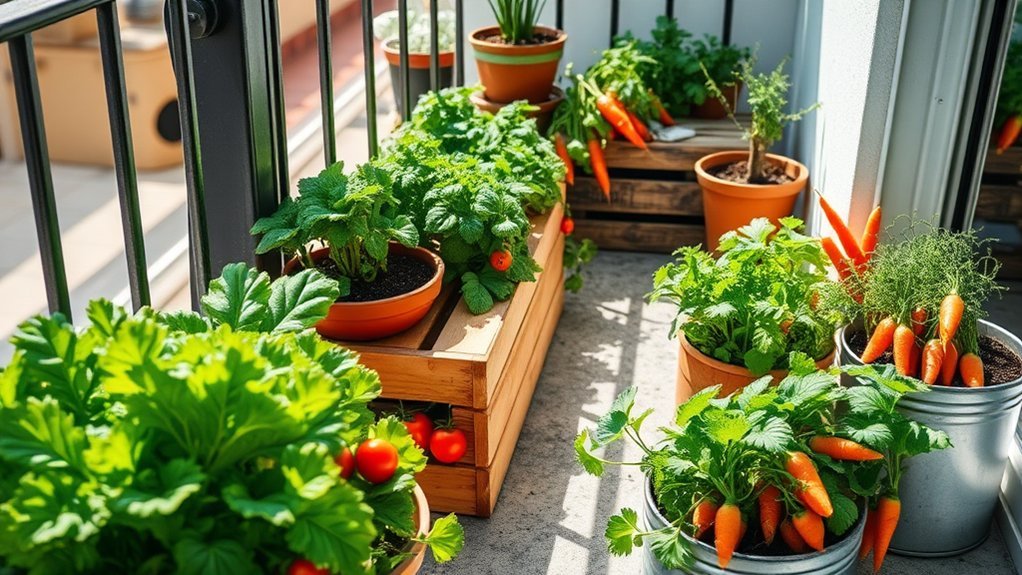
If you? ve got a balcony, why not try container gardening for your veggies? It? s a super way to build a balcony garden, even with limited room.
Make sure your spot gets 6 hours of sunlight daily for healthy vegetable growth. Pick pots with the right diameter? say, 12 inches for cherry tomatoes? to match the root systems of your plants.
Wondering what to grow? Go for dwarf vegetables or compact varieties like bush beans or mini peppers. They fit perfectly in small spaces.
Use vertical space with hanging baskets to add more vegetable varieties.
Don? t forget, regular watering is key since pots dry out fast. So, check the soil often.
Got a tiny balcony? No problem, just start small!
Utilize Vertical Gardens for Small Spaces
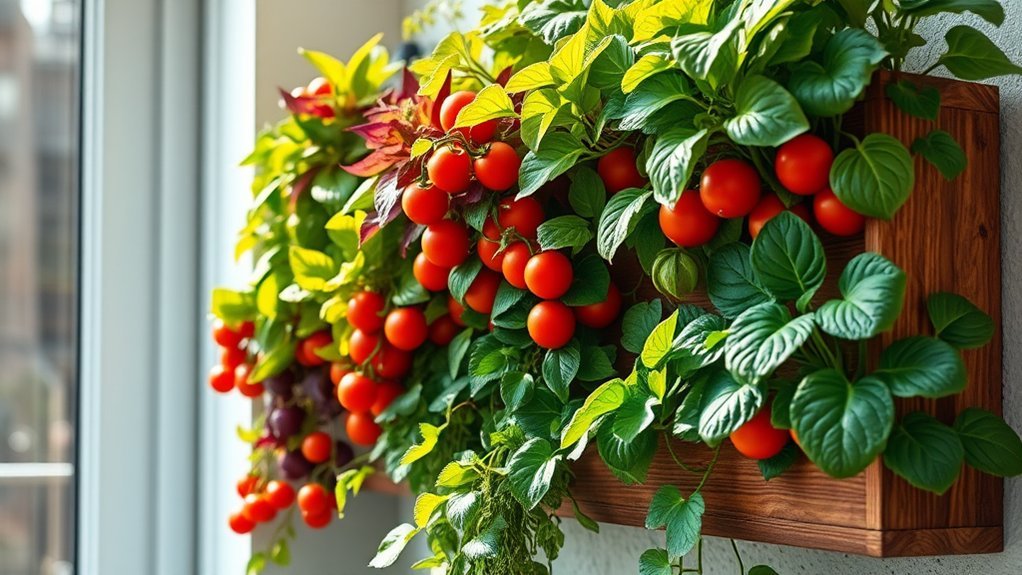
Hey, have you considered using vertical gardens to make the most of small spaces? If you? re tight on room, like in urban gardening, vertical gardens can save the day.
Grow vegetables like climbing beans or tomatoes using trellises to support climbing plants. It? s like giving your garden a high-rise building! This setup maximizes your small space, boosts air circulation, and cuts disease risks.
Transform small spaces with vertical gardens! Use trellises for climbing beans or tomatoes, enhancing air flow and reducing disease in your high-rise garden.
Try a container garden with wall planters, and move them around for optimizing light exposure. It? s perfect for vegetable gardening in tiny backyards. Plus, it looks pretty cool on your wall.
Got a balcony or patio? Vertical gardens work there too. So, why not stack up your veggies and watch them grow sky-high?
Design a Simple Herb Garden for Flavor
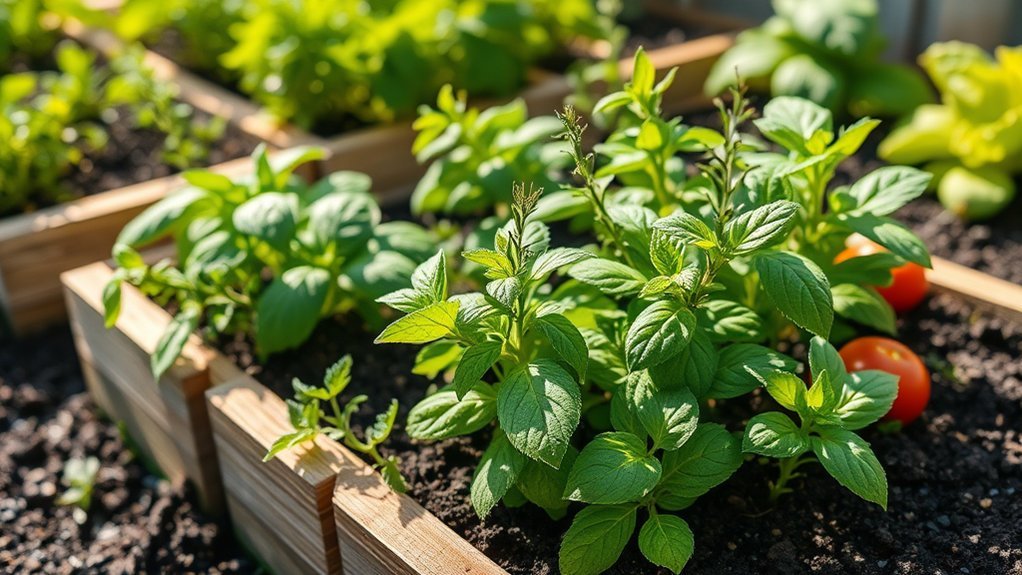
How about adding some tasty flair to your meals with a simple herb garden? It’s easy to start with a 3-4-foot raised bed or container, growing basil, oregano, and thyme. Make sure they get 6 hours of sun exposure daily in well-drained soil.
Ever tried companion planting? Pair herbs with veggies, like basil with tomatoes, to boost flavor and shoo away pests.
Got a tiny space? Use window boxes for easy access to fresh herbs. Regularly harvest by snipping top leaves to keep plants bushy.
Add organic fertilizers and mulch to retain moisture, keeping weeds out. Isn’t it cool to pluck your own herbs? Your kitchen creations will thank you for that extra zing!
Create a Salad Garden for Fresh Greens
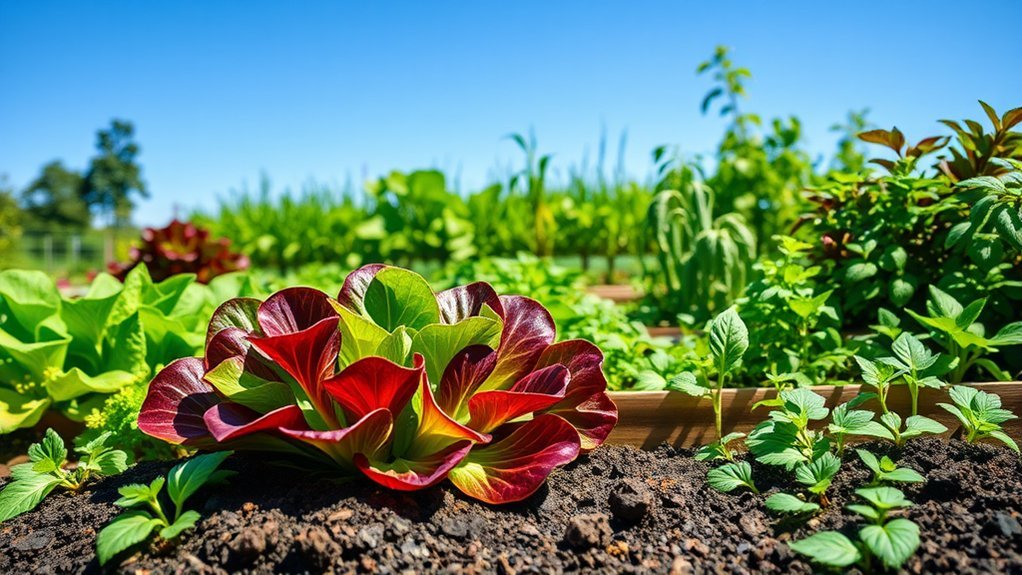
While you? re thinking about fresh flavors, why not create a salad garden for tasty greens? It? s a simple way to enjoy leafy greens and fresh veggies right from your yard. Pick a spot with 6 hours of sunlight daily, and you? re set to grow fast-growing varieties like lettuce and spinach. Use succession planting, sowing seeds every few weeks, for a continuous supply.
Try raised beds or container gardening to keep soil management easy and weeds away. Add companion herbs like basil to boost flavor and beauty.
How cool is it to pluck your own salad ingredients? With a little care, your salad garden will thrive, giving you crisp greens all season long without much fuss.
Build a Salsa Garden for Homemade Recipes
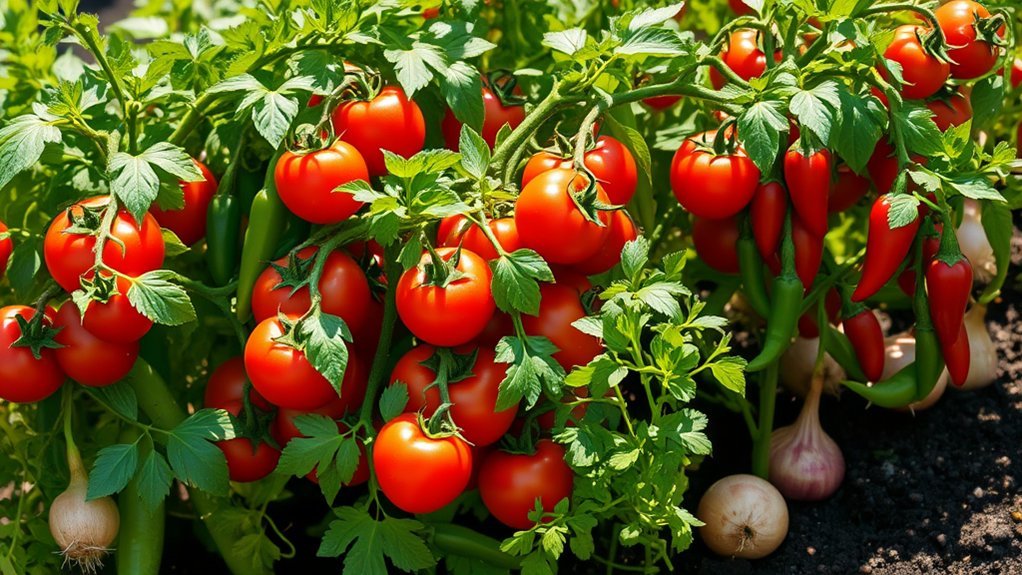
Ready to spice up your garden game after mastering those fresh greens? Let? s build a salsa garden in your home garden, using a small raised bed. Grow key vegetables like tomatoes (try Roma), peppers (jalapeño works great), and cilantro for bold flavors. Add a lime tree in a pot, and keep up with consistent watering for healthy plants.
Wondering what makes a salsa garden special? Check this out:
| Plant | Why You? ll Love It |
|---|---|
| Tomatoes | Juicy base for any salsa! |
| Peppers | Adds that spicy kick you crave. |
| Cilantro | Fresh, zesty taste every time. |
| Lime | Squeeze for perfect tangy vibes. |
Isn? t it like crafting a recipe right in your yard? Get planting today!
Incorporate Companion Planting for Better Growth
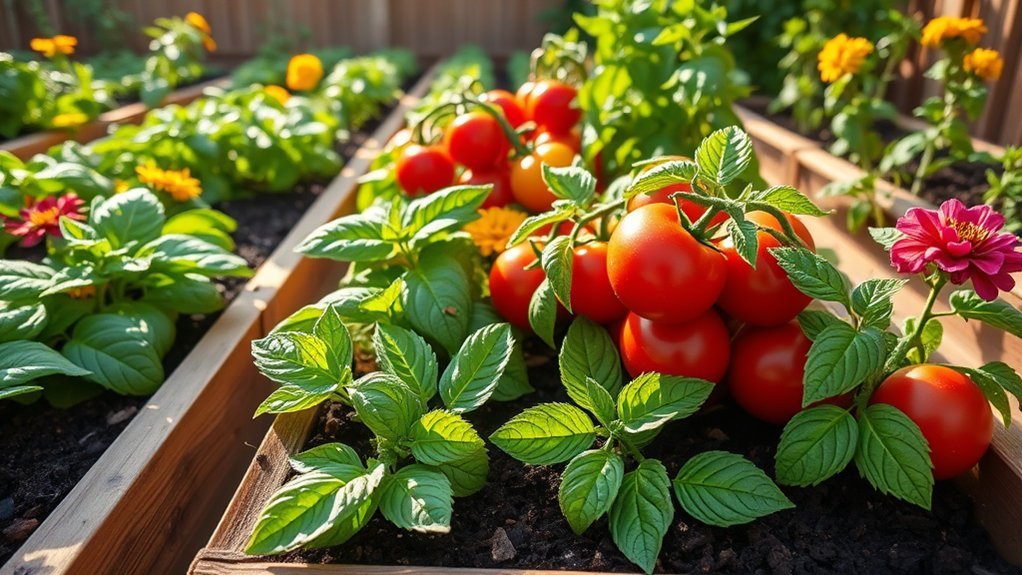
After setting up your salsa garden, let? s boost its growth with companion planting. This trick pairs plants that help each other, like tomatoes with basil, to fight off pests and improve flavor.
You can plant legumes, such as beans, near heavy feeders to enrich the soil for better crops. Plus, using ground cover like clover keeps weeds away and holds soil moisture, creating a healthy environment.
Want to attract good bugs? Add flowers like marigolds to draw beneficial insects while shooing away pests.
Companion planting builds a diverse garden, ramping up productivity and toughness against threats. Think of it as teamwork in nature! So, why not try it and see your garden thrive with less hassle?
Try Drought-Resistant Varieties for Low Maintenance
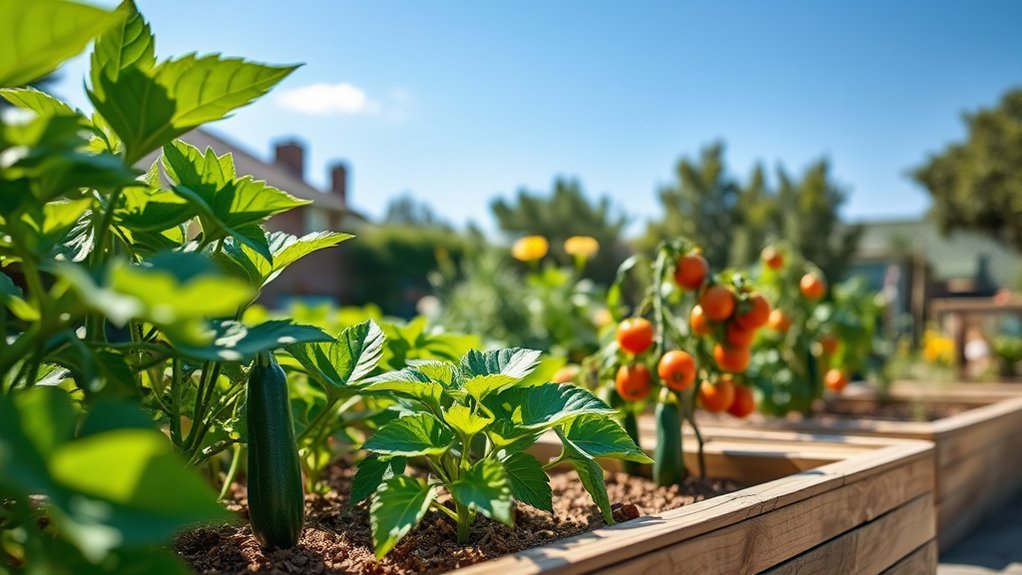
Since you? ve got your garden growing, let? s talk about making it easier with drought-resistant varieties.
These plants, including vegetables like cucumbers, tomatoes, and eggplants, need less water and thrive in dry conditions, perfect for low maintenance gardens. Their deep root systems dig down to find moisture, so you? re not watering every day. Pretty neat, right?
Want to save even more effort? Add organic matter and mulch to boost soil moisture retention.
This trick helps during water shortages or hot summer days, ensuring a successful harvest. Plus, choosing these varieties supports sustainable gardening by cutting water use.
Set Up Elevated Beds for Accessibility
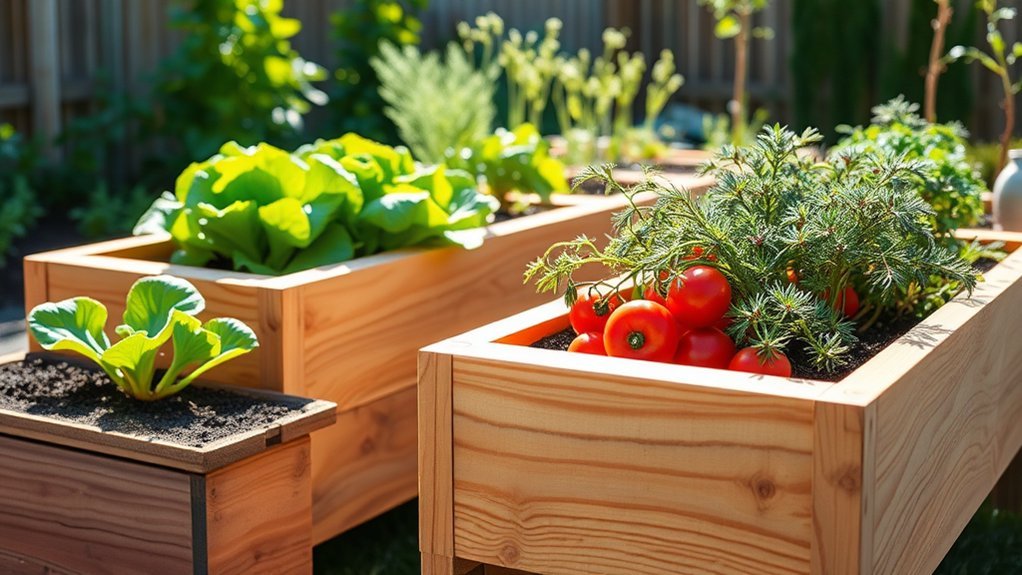
While you? re planning your garden, why not consider setting up elevated beds for easier access?
These raised garden beds boost accessibility, especially if bending down? s tough for you. They? re perfect for a vegetable garden in small backyards or urban gardening setups, and they cut down on maintenance.
Curious how they work? Let? s break it down with some quick perks.
- Build elevated beds 30-36 inches high, so you? re not stooping while planting.
- Enjoy better soil quality and drainage, keeping your plants happy and healthy.
- Start earlier with extended growing seasons, thanks to faster-warming soil.
- Fit them anywhere, even tiny patios, making urban gardening a breeze.
- Reduce weeding and upkeep, giving you more time to relax.
Mix Vegetables With Flowers for Beauty and Benefits
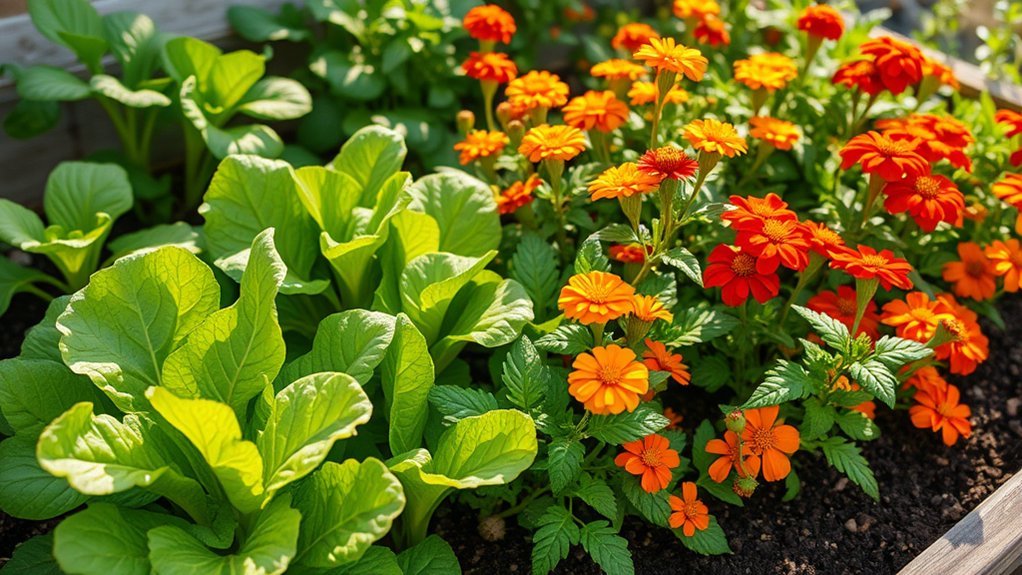
Hey there, let’s plunge into a cool idea for your home garden, mixing vegetables with flowers! Imagine a vegetable garden layout that’s not just useful, but pretty too. By using companion planting, you can pair tomatoes with marigolds to attract beneficial insects and deter pests. Edible flowers like nasturtiums add visual interest, enhance aesthetics, and keep bugs away. Plus, interplanting flower borders draws in pollinators, essential for crops like squash, and helps improve plant health.
Check out this table of combos to try:
| Vegetable | Flower | Benefit |
|---|---|---|
| Tomatoes | Marigolds | Deter pests |
| Carrots | Onions | Boost flavor |
| Squash | Nasturtiums | Attract pollinators |
| Peppers | Petunias | Enhance beauty |
Frequently Asked Questions
What Is the Easiest Vegetable Garden for Beginners?
Hey, wondering about the easiest vegetable garden to start? Delve into easy vegetable varieties like radishes, grab beginner gardening tools, and try container gardening tips. Focus on gardening soil essentials and raised bed designs!
What Is a Good Garden Layout for a Beginner?
Imagine chaos versus order in your backyard. Design a beginner? s garden with square foot precision using raised beds or container gardens. Prioritize sun exposure, soil drainage, garden spacing, vertical gardening, companion planting, crop rotation, and pest management.
What Vegetables Are Good for Beginners?
Hey, wondering what vegetables are good for beginners? Start with easy ones like lettuce and tomatoes using container gardening or raised beds. Try beginner herbs, seed starting, and companion planting. Master watering techniques too!
What Vegetables Go Well Together in a Garden?
As the saying goes, “birds of a feather flock together.” You? ll find success with companion planting by matching vegetable pairings for pest control, soil compatibility, sunlight needs, growth rates, harvest schedules, seasonal planting, crop rotation, and garden aesthetics.
Conclusion
Hey, you? ve got this gardening thing down with these 10 easy ideas! Picture your garden as a tiny farm, growing bit by bit, just like my neighbor? s patch started with one tomato plant and now feeds his family. Isn? t that cool? So, which idea are you trying first? Maybe raised beds or a simple salad garden? Get started, dig in, and watch your space, no matter how small, turn green and tasty!

